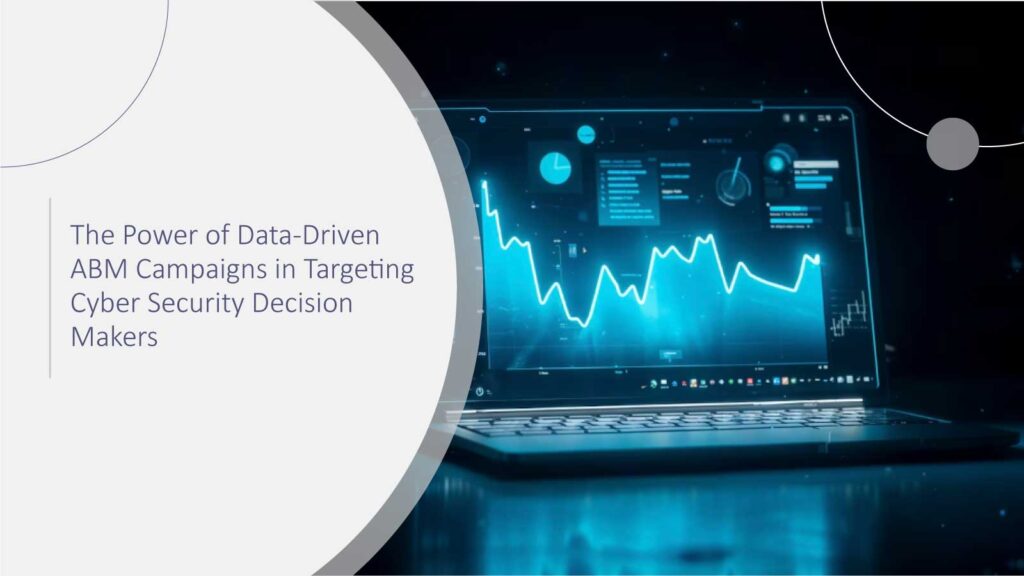Cybersecurity decision makers have become one of the most elusive targets in B2B marketing. While account-based marketing (ABM) has proven itself across various industries, standard ABM approaches often fall short when engaging Chief Information Security Officers (CISOs), security architects, and IT risk managers. This is not due to a flaw in the ABM model but rather a gap in how data is used to understand and engage this high-risk audience.
In today’s threat landscape, trust is the single most important currency in the security sector. CISOs expect vendors to know not just their company name and industry but their specific risk posture, regulatory context, and emerging challenges. This is where data-driven ABM proves its true power. Additionally, transforming generic outreach into highly relevant conversations that break through skepticism and spark meaningful engagement.
This article explains why cybersecurity buying cycles demand a more sophisticated, data-informed ABM strategy, what elements make such campaigns successful, and also, how one vendor turned data-driven ABM into a measurable pipeline growth engine.
Understanding the Cybersecurity Buyer
Security decision makers have a different mindset from general tech buyers. Unlike other IT roles focused on functionality and cost efficiency, CISOs carry the responsibility for defending their organizations against cyber threats that could cost millions in damages or cause lasting reputational harm.
This burden shapes how they interact with potential vendors. Security leaders prioritize credibility over features. They seek proof, not promises. They ignore generic pitches but respond to highly contextualized, risk-specific insights. To complicate matters further, they work under tight budgets, regulatory scrutiny, and a constant stream of vendor noise, making their attention even harder to win.
As a result, marketers and sales teams cannot rely on broad persona profiles or basic firmographics alone. They need richer, near-real-time intelligence about what a specific account cares about today, how it reacts to industry threats, and also where it is in the buying journey. This level of insight is only possible through data-driven ABM.
Why Data-Driven ABM Works Better
Indeed, Traditional ABM focuses on defining an ideal customer profile (ICP), selecting target accounts, and delivering personalized content. While this foundation is still necessary, it is no longer enough for cybersecurity buyers.
Modern data-driven ABM enhances this foundation with multiple layers of intelligence:
1. Intent Data:
Intent signals capture digital behaviors, like searches for ransomware protection, compliance checklists, or breach remediation guides. This shows when an account is actively researching a solution related to your offering.
2. Technographic and Firmographic Data:
Knowing a target’s existing security stack, cloud maturity, or specific compliance certifications helps tailor outreach to fit their environment, not just their industry.
3. Behavioral and Engagement Data:
Tracking how a contact interacts with your website, webinars, or gated reports refines your understanding of interest and readiness.
4. Threat Intelligence Context:
Overlaying ABM data with real-world threat trends provides unique relevance. For example, if a company recently experienced a supply chain breach, mentioning how your solution mitigates similar risks builds immediate credibility.
This layered intelligence enables marketing and sales to deliver messaging that is not only personalized but contextually urgent. The result: higher engagement rates, faster conversions, and stronger trust.
Key Elements of a Data-Driven ABM Campaign for Cybersecurity
Precise Segmentation
Successful ABM starts with identifying high-value accounts using detailed criteria. Basically, in cybersecurity, segmentation goes beyond revenue size and region. Teams should consider regulatory exposure (e.g., PCI DSS for financial firms), recent breaches, or mergers that may trigger new security needs. This approach prioritizes accounts most likely to benefit from your solution now.
Hyper-Relevant Messaging
Once accounts are segmented, outreach must speak directly to the challenges those organizations face. Rather than sending broad product pitches, content should address immediate risks, such as new compliance deadlines, the rise of insider threats, or securing hybrid workforces. When your emails, ads, or calls tie directly to real challenges, decision makers are more likely to respond.
Useful Content and Tools
Security leaders respond well to content that educates rather than sells. Sharing analyst-backed reports, threat landscape updates, or eventually checklists for audit readiness positions your brand as a trusted advisor. Some vendors create interactive tools, like breach cost calculators or policy templates, to deliver tangible value upfront.
Cross-Team Alignment
Data-driven ABM demands tight collaboration between marketing, sales, and also sometimes customer success teams. Shared dashboards help track account-level engagement, intent spikes, and pipeline progression. This alignment ensures that when a security leader shows interest, sales follows up with relevant context, not a generic pitch.
Continuous Optimization
Finally, successful ABM in cybersecurity is not static. Buyer signals change rapidly as new threats emerge or budgets shift. Teams must regularly review account data, engagement metrics, and campaign performance. So, by refining segments, updating messaging, and testing new assets, they keep campaigns fresh and effective.
Real-World Case Study: Turning Data into Deals
Consider the example of a European cloud security provider that struggled to win meetings with CISOs at large financial institutions. Their original ABM strategy focused on broad value propositions like “flexible cloud protection” and “cost savings.” However, engagement was low, with open rates under 20% and conversion rates even lower.
After partnering with a demand generation agency, the vendor redesigned its ABM approach using advanced intent and technographic data. Certainly, they began monitoring which financial institutions were searching for information about multi-factor authentication, zero trust architecture, and insider threat detection.
They created targeted content assets, like a “Zero Trust Readiness Scorecard” and a short risk assessment tool specific to banking security risks. Outreach emails cited recent incidents affecting financial companies and explained exactly how their solution prevented similar breaches.
The result was a dramatic improvement:
- Email open rates increased to 45%
- 30% of engaged contacts requested the risk assessment
- Within four months, five high-profile banks moved from cold accounts to active opportunities
By using deeper account intelligence and threat-specific context, the vendor built trust where generic ABM could not.
Actionable Takeaways for Cybersecurity Marketers
Data-driven ABM is not an overnight fix; it’s an ongoing discipline. Here are practical ways to start or strengthen your efforts today:
Focus first on the quality of your data. Invest in intent providers, threat intelligence partners, and technographic data sources that cover the security market.
Align your marketing and sales teams to interpret and act on this data together. Weekly stand-ups, shared KPIs, and transparent reporting reduce guesswork.
Create content that answers “why now?” for each targeted account. This might be a fresh threat report or a compliance timeline reminder.
Finally, measure not just clicks and opens but real pipeline impact. Track how well your campaigns shorten sales cycles, increase deal sizes, and improve win rates.
Done right, data-driven ABM does more than generate leads; it builds trust with the world’s most skeptical buyers.
Conclusion
Cybersecurity decision makers operate in an environment where trust is built slowly and lost instantly. To earn their time and business, generic marketing is simply not enough. Data-driven ABM gives vendors the intelligence to approach each target with insight, relevance, and context, showing they understand not just the buyer’s company but its most pressing risks.
As the threat landscape grows more complex and budgets grow tighter, vendors that use data to engage the right accounts at the right time will have a clear advantage. For companies ready to compete seriously in the cybersecurity space, data-driven ABM is no longer optional; it is mission-critical.
FAQs
1. Why is ABM more challenging for cybersecurity than other industries?
Cybersecurity buyers are trained to be skeptical and risk-averse. They receive high volumes of outreach but trust few vendors. To succeed, marketers must deliver highly relevant, timely, and proof-backed messaging, which standard ABM often lacks.
2. What kind of data is most valuable for targeting CISOs?
Intent data showing current research activity, technographic data revealing the existing security stack, and real-world threat intelligence related to the account’s industry are crucial. Together, they allow for precision targeting and tailored messaging.
3. How does threat intelligence enhance ABM campaigns?
Adding threat context to ABM messaging makes outreach timely and urgent. For example, if a target account’s sector recently faced a phishing attack spike, referencing this in your message builds credibility and shows you understand their challenges.
4. Can small or mid-sized vendors run data-driven ABM campaigns effectively?
Yes. While large enterprises may have bigger budgets, smaller companies can focus on fewer high-value accounts and use cost-effective data sources to achieve similar results. The key is disciplined segmentation and personalized content.
5. How do I measure success in a data-driven ABM campaign for cybersecurity?
Look beyond basic email metrics. Track account-level engagement, progression through the sales funnel, pipeline contribution, deal velocity, and win rates. Therefore, these KPIs show whether your ABM is influencing real revenue outcomes.
To participate in our interviews, please write to us at sudipto@intentamplify.com







